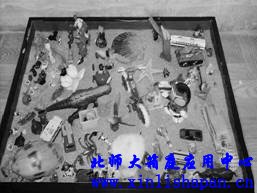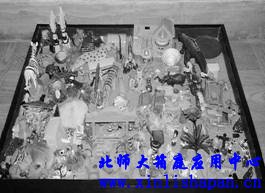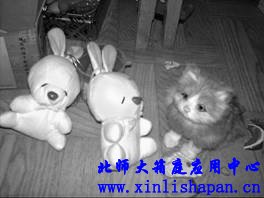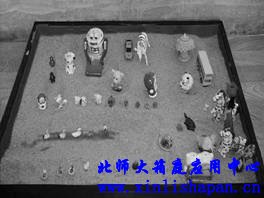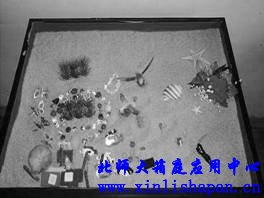The production of children's Sandplay therapy is a dynamic game process, which is both fun and thought-provoking. Through the production of Sandplay therapy and works of Sandplay therapy for young children, we found that they have the following characteristics. 1. Introduction of Sandplay Therapy for Infants The study found that the mentor of Sandplay therapy for young children introduces the production of Sandplay therapy to young children who experience Sandplay therapy for the first time, so that they can invest in Sandplay therapy games in the following six forms (see Table 3). The guides for infants ’Sandi therapy are mainly guided by witnesses and the cooperation between the witnesses and their parents. There are a total of 8 people. From the perspective of the guide method, the combination of sand and speech is mainly used, and there are 6 people. Second, the production time In this study, the longest time for children to make Sandplay therapy took 75 minutes, the shortest took 10 minutes, and the average time for 10 people was 32.4 minutes. Ten children said they liked this form of play very much after making a boxing therapy work, they did n’t want to leave, they wanted to remove it and put it back on. Third, the movement of sand During the production process, the children have moved the sand tools, or moved the sand tools that have been put on the position, or replaced the sand tools, as shown in Table 4. The least moves are less than 5 times, there are 2 people, and the remaining 8 people are more than 5 times, of which 5 are more than 10 times. Table 4 Statistics of the frequency of mobile sand for children 4. The basic composition of the work (1) Number and type of sand tools Table 7-5 shows the total number of sands and the percentages of sands in 10 children's sandplay therapy works. Animal sands are the most used by 8 people, and the sands of other types do not show obvious advantages. The types of sands ranked second in number include figures (3 persons), plants (3 persons) and supplies (4 persons). (2) Use of sandbox Although young children are more likely to be exposed to sand than adults, such as playing by the sand mounds on the construction site, playing in the sand ponds in kindergartens, and playing by the river or the beach by the sea, when telling these children, When they are allowed to use a variety of toys to casually place or do something in the sandbox, they rarely move sand, let alone use sand to build mountains or dig rivers (as shown in Table 6, table The number in refers to the number of people). Only 3 of the 10 children used to move the sand. One was digging sand to make a river. One was gently gathering the sand to form a hill, and the other was scooping the sand with a spoon to play. Note: The numbers in the table are the number of young children (3) Space use Researchers divided the use of space into four types: "partial" refers to a part of the space that uses only one sandbox, "occupied" refers to filling the entire sandbox with toys (see Figures 1 and 2), and "two sands" "Box" refers to making two sandboxes at the same time. "Others" includes placing toys on the edge of the sandbox, or playing games outside the sandbox, and placing toys outside the sandbox (see Figures 3 and 4). It can be seen from Table 6 that 8 of the children participating in this study filled the entire sandbox, and only one person placed the toys outside the sandbox and played the “play house†game outside the sandbox. Most of the children will say "full" after the production is completed. For them, the completion of the sandbox works seems to mean filling the entire sandbox. In addition, a child had difficulty adapting when she started to enter the playroom. The researchers tried to communicate with her with various toys to attract her into the play area. But after she became familiar with the toys, she quickly filled up her favorite toys. One sandbox, followed by another work, so two sandboxes were used in the end. Figure 1. The box work of a 4-year-old boy S.JY [It reflects Ultraman (Superman in the cartoon) playing monsters (dinosaurs). It happened on the seaside. The house is the home of Superman. There are people reading books and other animals around the house. ] Figure 2. The 5-year-old girl's box work by W.XM (Children and animals are happy to play together. The house is the child ’s home. The lions, leopards, and dinosaurs around the house are toys for the children. The parents of the children are in the house. The treasure chest is the wallet of the parents and parents. .) Figure 3. The box work of a 3-year-old girl W.ZQ (The little animals are playing games. The little brothers are playing football. The mother, sister and children are in the lower right corner.) Figure 4. W.ZQ's game outside the sandbox (The names of the two little white rabbits are "Duo Duo", and they are children of "Mom", and the kittens are accompanied to play. During the whole game, "Mom" is busy buying food to cook for "Duo Duo". "Duo Duo" is ill, and "Mother" is busy giving medicine to take care of "Duo Duo".) 5. Theme The theme of the work discussed in this research is based on the children ’s own reports. Table 6 shows that there are 6 children who ca n’t clearly report the theme of their works. When the researchers asked them: “You can give yourself the works Do you have a name or title? "They all answered that they didn't know, but they could give a rough idea about a part of the sandbox. There are two works with clear themes. They are "All Animals Amusement Park" and "Animals Watching Geese" (Figure 5). There is a work that reflects family life, and most of the toys used are also furniture, but children are limited by language expressions, and they ca n’t say it accurately, only “their homeâ€. In addition, the child who made two works, her first work has no theme, but the second work has a clear theme called "Little Grass's Birthday" (Figure 6), because that day coincides with the child's On her 5th birthday, she reflected the scene of her birthday into the boxing works, so the researchers classified this kind of content into the life scene category. Figure 5. The 4-year-old girl LJY's box work: animals watching geese (The goose in the front is the father, the goose in the back is the child, they are swimming, other animals come to see the goose swimming, the sister in the lower right corner leads the sister to play here, they also come to see the goose, the sister tells the sister to say : "Don't run around, or you will lose it.") Figure 6. A 5-year-old girl ’s box work: Xiao Cao ’s birthday (The grass surrounded by the colored glass beads is the girl herself. The other grass is the auntie grass. She came to give grass a birthday. She gave the grass a necklace as a gift. The butterflies, small fish, Piggy and Asuka are both here to celebrate Xiao Cao's birthday. Two cakes are placed on the table in front of Xiao Cao. There are five candles around the cake. Everyone sings the birthday song around the candles.) 6. Interaction between young children and witnesses during the production process As a witness to the production of children ’s boxes, the obvious feeling of the researchers is that most children are making boxes while talking to themselves, such as the girl L.JY who made the "animal watching geese" works and said : "Dig a river first. There are geese in the river. The goose is the father in the front and the child is in the back. Then the mother of the piglet takes the piglet to see the geese. Puppies, kittens, baby elephants and chickens They all came to see the geese. The little monkeys and bears came later. They were late ... Here is the older sister who took the younger sister to see the geese. For example, the girl who made "Little Cao's Birthday" said, "Xiao Cao's birthday today, a lot of small animals came to her birthday, they gave Xiao Cao a lot of gifts, and Aunt Cao came, she gave Xiao Cao A necklace, a birthday cake and candles on the table, and the pagoda candy that Xiao Cao likes to eat are on the table. Xiao Cao is very happy today. "After putting the candles on, she clapped her hands and sang birthday songs with the witnesses. Other children not only talk to themselves, but also actively communicate with witnesses, ask questions, or invite witnesses to participate in their box games. In short, the interaction in the production process of the children's box court is more frequent than that of the adult box court, and the game nature of the box court is more obvious. Whiteboard and Bulletin Board Fittings White Board Magnets,Colorful White Board Magnets,Different Size White Board Magnets,Cork Board Used Push Pins WENYANG STATIONERY MANUFACTURING CO.,LTD. , https://www.marvelousboard.com
